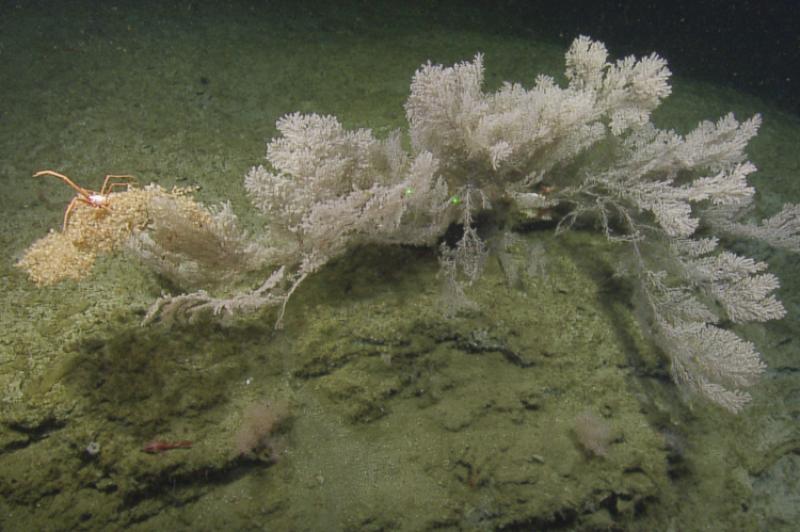NOAA and partners have recently completed the second West Coast Deep-Sea Coral Research Initiative and released the final report (PDF, 83 pages). The extraordinary level of collaboration on this initiative resulted in major accomplishments that are helping to inform management and stewardship of deep-sea ecosystems. Vibrant deep-sea coral and sponge communities make their home across a diversity of seafloor features throughout the West Coast, such as seamounts, basins, and submarine canyons. Deep-sea corals and sponges are important to their surrounding ecological communities. Many have been designated as essential fish habitat because they are vital to the health of recreational and commercial fisheries.
Initiative Highlights
Habitat Observations
Scientists recorded new observations of habitats with high densities of deep-sea corals and sponges. This information has greatly improved our understanding of relatively high bycatch “hot spots” of these organisms and impacts to them in areas newly reopened or closed to seafloor-contact fishing. During the initiative, researchers completed baseline surveys or re-surveyed these areas to monitor the impact of the reopenings or closures over time.
Petrale Sole
Scientists further documented a petrale sole spawning area in the proposed Chumash Heritage National Marine Sanctuary. Petrale sole is an important commercially harvested fish species on the West Coast. Researchers observed the flatfish on the seafloor, sometimes forming “piles”—a behavior they believe to be related to spawning.
Glass Sponges and Skeletons
An expedition team discovered vast mounds of glass sponges and their skeletons in Channel Islands National Marine Sanctuary. Large sponge mounds like these are an important and exceedingly rare find. They can provide habitat for a variety of life forms and teach us more about how the deep ocean responds to changing environmental conditions.
New Tools and Products
The initiative resulted in the development of a variety of new tools and products. These include a West Coast identification guide for deep-sea corals and fish, improved genetic approaches to better understand the taxonomy and biology of deep-sea coral and sponge communities, and an online tool to help prioritize areas of the seafloor to map.
Public Engagement
We had many creative and engaging opportunities for the public to learn about and connect with deep-sea coral and sponge ecosystems. Examples include livestreamed remotely operated vehicle dives, 3D coral prints for classroom instruction, and new content for the West Coast National Marine Sanctuaries Deep Coral Communities Curriculum. Education and outreach efforts like these foster public understanding and stewardship of our oceans.
Deep-Sea Coral Initiatives
NOAA’s Deep Sea Coral Research and Technology Program, within the Office of Habitat Conservation, funded the West Coast Deep-Sea Coral Research Initiative. The Program’s multi-year initiatives take place on a rotating schedule across each region of the United States. They provide important information needed for sustainable management of fisheries and other activities that may benefit from or affect deep-sea coral ecosystems.
The West Coast Deep-Sea Coral Research Initiative ran from 2018 through 2021. It was designed to better understand deep-sea corals and sponges off the coasts of California, Oregon, and Washington, particularly within the five West Coast national marine sanctuaries.
Partnerships Are Key
To make the initiative a success, the Program leveraged its extensive network on the West Coast, which has been a hub of innovation in ocean exploration for decades.
One particularly notable collaboration is EXpanding Pacific Research and Exploration of Submerged Systems, an ongoing cooperative research campaign that began in 2017. NOAA, the Bureau of Ocean Energy Management, and the U.S. Geological Survey lead the campaign. During the initiative, the campaign partnered with the Global Foundation for Ocean Exploration, Marine Applied Research and Exploration, Monterey Bay Aquarium Research Institute, and Ocean Exploration Trust/Nautilus Exploration Program to conduct expeditions and surveys focused on deep-sea coral and sponges.
Although the initiative has drawn to a close, the momentum behind it has not. Ongoing projects will continue to support deep-sea coral and sponge research and conservation efforts on the West Coast.





